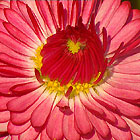| English daisies are trouble free and easy to grow, which is why they have been garden favourites since the early 16th century. Long ago they were given the name ‘day’s eye’, because the flowers close at dusk and open again at dawn. ‘Day’s eye’ became ‘daisy’, the name we now give to this and many other plants with similar flowers. Daisies appear to be single flowers, but each one is actually made up of numerous small flowers, or florets. The tubular ones in the centre are called disc florets. The ones around the outside have a long, single petal attached, and are called ray florets Plant details |
| Common name: | English daisy |
| Botanic name: | Bellis perennis |
Description: |
A short-lived perennial usually grown as an annual. Many cultivars have now been developed. They are available in semi-double and double forms in a range of colours from white to pale salmon, through to pink, red and crimson. Some have extra ray florets tightly packed into a hemispherical cushion shape. |
Best climate: English daisies thrive in cool, moist climates. Uses: |
borders
rock gardens
containers
companion plant to spring flowering bulbs
Cultivation:
If planted in autumn, English daisies will begin flowering in late winter in most districts. They like a position in sun or part shade, in well-drained soil. Feed with a liquid fertiliser, such as Nitrosol, and deadhead spent flowers to prolong the blooming period. Propagation is by seed or division.
Getting started:
English daisy seeds and seedlings are readily available at nurseries and garden centres.



